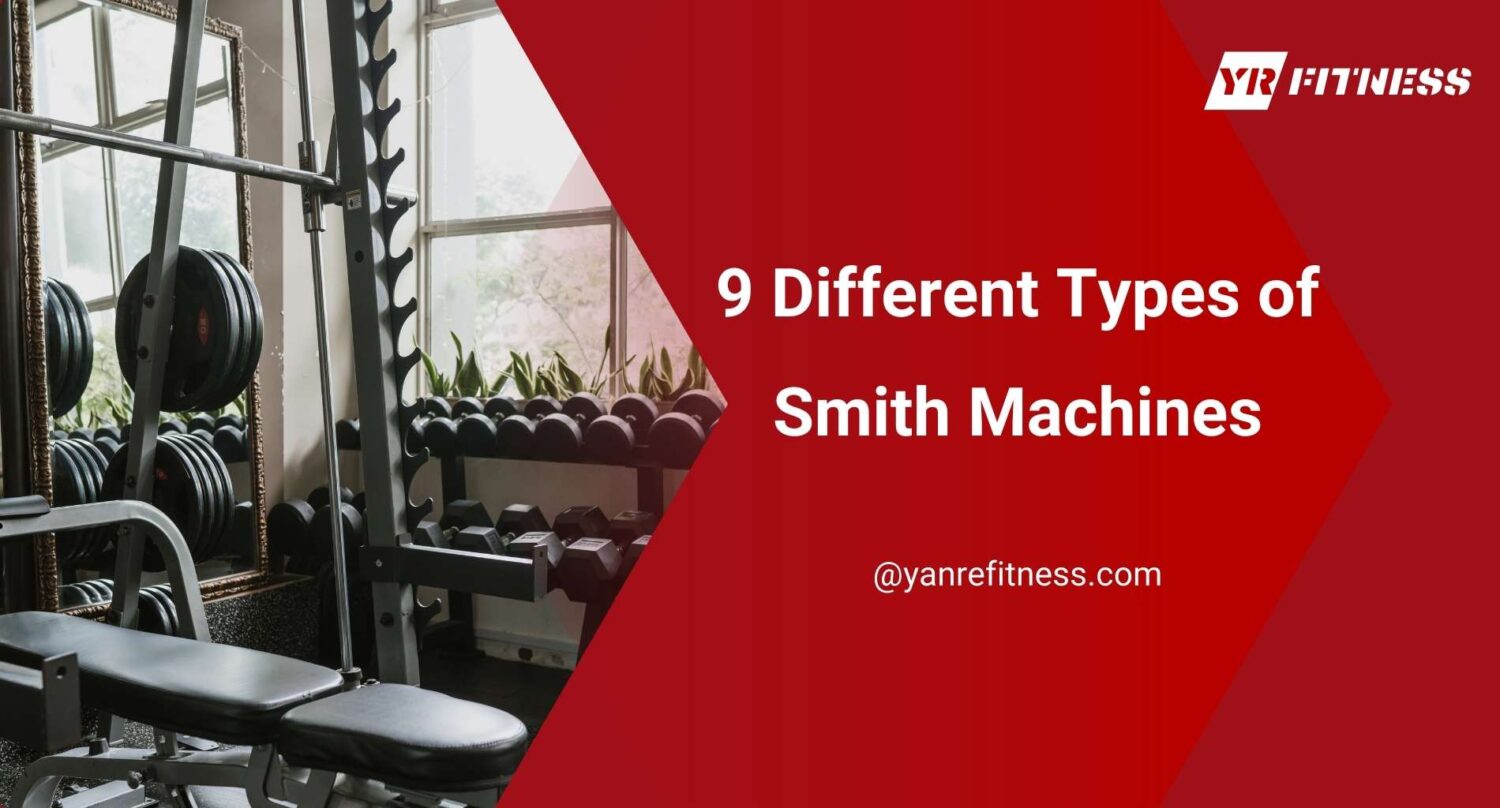Ever spent thousands on a machine your clients barely use? I have.
Years ago, I picked a Smith machine without doing the research. It looked good. Price was decent. But it didn’t meet our needs. Members avoided it. I ended up reselling it. At a loss.
That mistake pushed me to learn about the different kinds out there. Today, I own three types of gym. And each gets used to it every day.
I’m writing this to help you skip that pain.
This article covers 9 different types of Smith machines. I’ll explain how each one works, who it’s for, and what kind of training it’s best for.
By the end, you’ll have a simple guide to help you pick the one that fits your gym best.
Let’s dive in!
Table of Contents
Comparison Chart
Need a quick summary before we break things down? The table below compares all 9 Smith machines at a glance—cost, features, and who they’re best for.
Type | Avg. Cost | Key Features | Best For | Main Limitation |
Vertical Smith | $600–$1,200 | Straight path, compact size, low maintenance | Beginners, small gyms | Rigid movement, limited versatility |
Angled Smith | $1,000–$2,000 | 7–12° tilt, smoother motion, body-friendly | General fitness gyms, joint safety focus | Costs more, needs more space |
Counterbalanced Smith | $1,500–$3,000 | Offset bar weight, smooth feel, sleek look | Rehab clients, beginners, quiet training | Feels too light for heavy lifters |
3D Smith | $2,000–$4,000 | Moves in all directions, advanced bearing system | Functional training gyms | Higher cost, more complex to teach |
All-In-One Smith | $2,500–$5,000 | Combines Smith, cables, pull-up, storage | Space-limited gyms, personal trainers | Busy design, more cleaning needed |
Commercial Smith | $3,000–$6,000 | Heavy-duty build, large frame, anti-rust | High-traffic gyms, serious lifters | Expensive, takes up more space |
Home Smith | $700–$1,500 | Compact, quiet, foldable benches | Home gyms, light use setups | Limited capacity, basic movement set |
Dual-Track Smith | $2,500–$4,500 | Dual rails, stability focus, linear bearings | Rehab, form training, smaller studios | Not good for explosive lifts |
Multi-Angle Smith | $3,000–$5,500 | Adjustable bar paths, rotating track, labeled angles | Custom training, small group sessions | More complex, longer setup time |
That gives you a solid overview—but we’re just getting started. Let’s break down each machine in detail.
1. Vertical Smith Machine
This was the first Smith machine I added to my gym. I picked it because it looked simple and didn’t take up much space. At first, I thought it was a smart buy. But soon, I learned that not every machine works well for every gym.
A vertical Smith machine moves the bar straight up and down—no angle, just a fixed path. That sounds easy, but it can really change how lifts feel.
Average Cost: Usually ranges from $600 to $1,200, depending on brand and build.
Features
- Straight Vertical Path: Guides the bar up and down without tilt.
- Fixed Bar Carriage: Locks the bar onto solid rails for full control.
- Safety Peg System: Bar can be stopped and hooked mid-rep.
- Minimal Footprint: Compact build fits tight gym layouts.
- Low Maintenance Parts: Simple build means fewer breakdowns.
- Welded Frame Design: Stronger build in one-piece commercial models.
- Average Cost: Typically priced around $600 to $1,200.
Advantages
- Helps Teach Form: Keeps newer lifters aligned through each rep.
- Good for Isolation Work: Ideal for shrugs, calf raises, and partial range lifts.
- Cost-Effective for New Gyms: Lets you offer a bar path option without overspending—a smart move for anyone following a small gym business plan.
- Safe Solo Training: Lock points add confidence when lifting alone.
- Easy to Clean: No cables, no extra attachments.
Disadvantages
- Lacks Natural Movement: Doesn’t match real lifting mechanics.
- Limited Range: Fixed bar limits how creative your programming can be.
- Low Appeal for Athletes: Experienced lifters usually skip it.
A vertical Smith machine can still be the right call—if you know your members and space. Is your crowd more beginner-focused or looking for structure in their lifts? Then this might be your reliable workhorse.
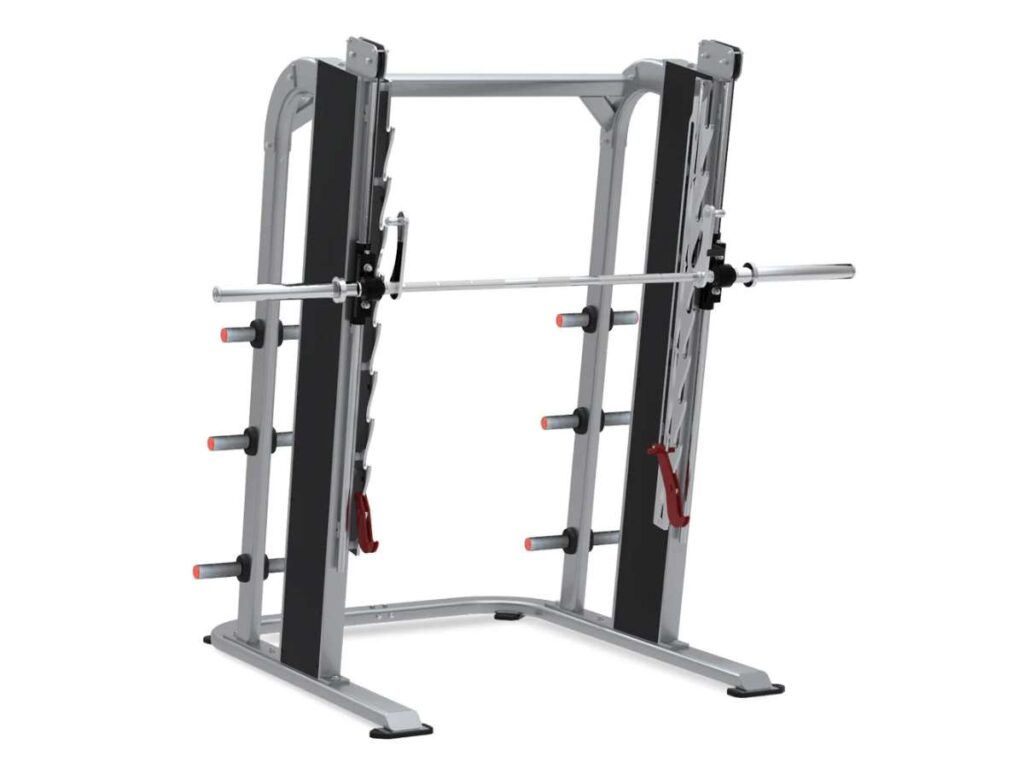
2. Angled Smith Machine
After learning my lesson with the vertical Smith machine, I tried something different. That’s when I found the angled Smith machine. Right away, it felt better. More natural. My members agreed.
An angled Smith machine guides the bar along a slanted path—usually about 7 to 12 degrees. That slight tilt makes a big difference. It matches how your body naturally moves during lifts like squats or presses.
It still keeps things controlled and safe, but it feels more like free weights.
Average Cost: Usually ranges from $1,000 to $2,000, depending on features and quality.
Features
- Slanted Bar Path: The bar moves along a slight angle, not just straight up and down.
- Built-in Safety Stops: Users can rack the bar anytime during a lift.
- Balanced Resistance: Often feels smoother than vertical models.
- Mid-Sized Frame: Fits most gym spaces without feeling cramped.
- Better Body Mechanics: Designed to match joint motion during lifts.
- Sturdy Construction: Often used in both commercial and home gyms.
Advantages
- More Natural Movement: The tilt follows your body’s natural lifting path.
- Comfortable on Joints: Less pressure on knees, shoulders, and lower back.
- Versatile for All Levels: Great for beginners and experienced lifters alike.
- Increased Use: More members will actually want to use it.
- Reliable Build: Built stronger than basic vertical versions.
- Smooth Motion: Feels more fluid during reps.
Disadvantages
- Higher Cost: More expensive than vertical machines.
- Takes More Space: Slightly deeper frame footprint.
- Less Ideal for Pure Beginners: Movement path is less “rigid,” which some may find tricky at first.
If you’re managing a gym and want a machine that keeps clients coming back, this one’s worth considering.
It offers better biomechanics, wider appeal, and a smoother lifting experience—all factors that support long-term member satisfaction and smarter equipment investment.
Additionally, if you’re looking for more durable gym equipment to add to your space, consider YR Fitness. Our machines are built to last through daily use, offering strong performance, smart design, and the kind of reliability your members expect.
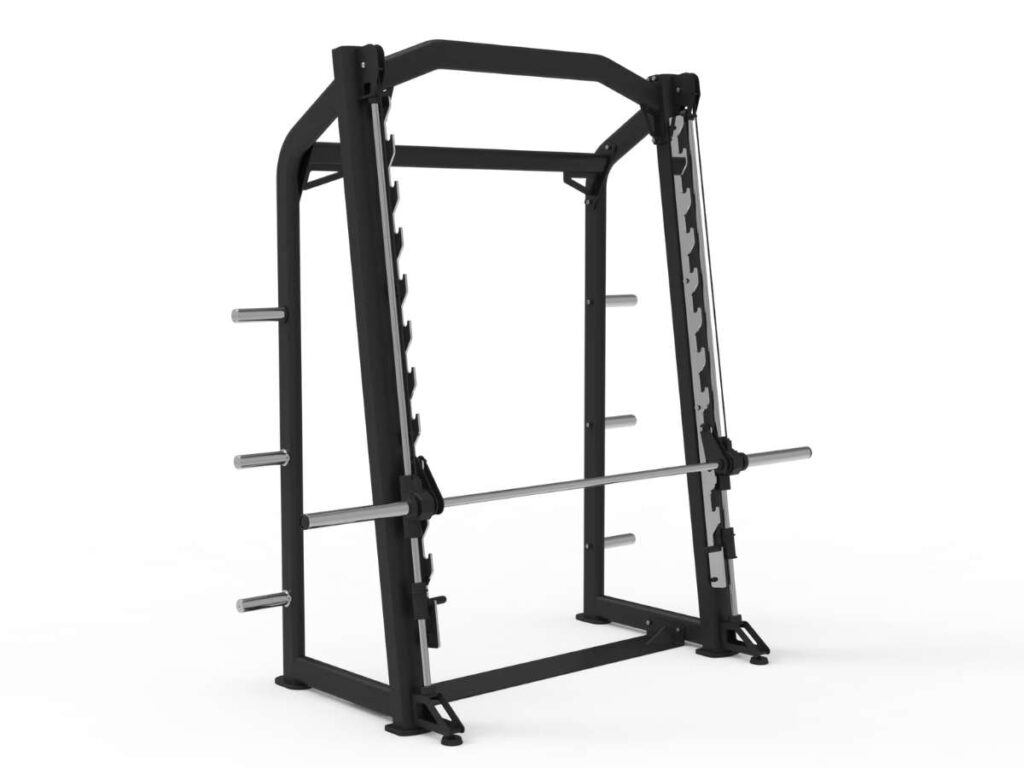
3. Counterbalanced Smith Machine
A counterbalanced Smith machine has a system that offsets the weight of the bar. That means the bar starts at nearly zero pounds, even though the bar itself might weigh 30–45 lbs. This makes it easier for beginners or rehab clients to get started. It also allows more control in training progression.
As a gym owner, this type of Smith machine can serve a wider range of members.
Average Cost: Typically ranges from $1,500 to $3,000 based on brand and build.
Features
- Counterweight System: Balances out the weight of the bar so users lift only the added plates.
- Smooth Bar Movement: Often uses cables or pulleys to assist movement.
- Precision Racking Points: Lets lifters stop the bar at many levels.
- Balanced Starting Weight: Feels light right from the first lift—great for beginners.
- Sleek Design: Often looks more advanced and modern.
- Dual Use: Works well in both commercial and rehab-focused spaces.
Advantages
- Beginner-Friendly: New clients won’t feel intimidated by the starting weight.
- Supports Rehab Training: Safer for clients recovering from injuries or surgeries.
- Precision Control: Good for fine-tuning movements in training programs.
- Quiet Operation: Less metal clanking—more comfortable in quieter studios.
- More Member Options: Lets you serve more age and skill levels.
- Added Safety: Helps reduce strain, especially on first reps.
Disadvantages
- Higher Price: More moving parts and features push the cost up.
- Extra Maintenance: Counterweight systems need more upkeep.
- May Feel “Too Easy”: Advanced lifters might feel it’s not challenging enough.
The counterbalanced Smith machine might be a great investment if your gym serves a mixed crowd—new lifters, older clients, or people in recovery. This machine can fill a real need. It’s not just about lifting heavy. It’s about giving every member a way to start safely and build confidence.
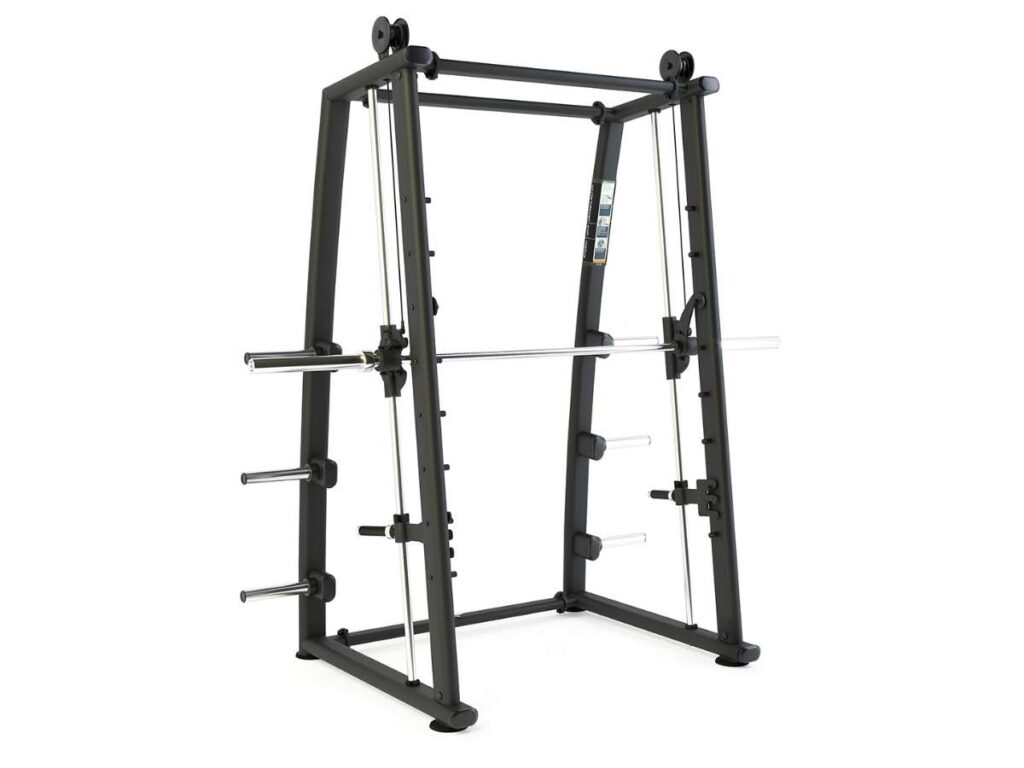
4. 3D Smith Machine
I’ll be honest—I was skeptical of the 3D Smith machine at first. The idea of the bar moving forward, backward, and up and down? It sounded like a headache.
But once I tried it, I got it. The freedom of movement feels closer to free weights, but you still get the safety of a Smith machine. Clients who want more natural lifting paths tend to love it.
This machine isn’t just about control—it’s about movement. And that matters.
Average Cost: Generally priced between $2,000 and $4,000.
Features
- Multi-Directional Movement: Bar moves both vertically and horizontally.
- Guided Tracks with Freedom: Allows users to shift naturally while still staying safe.
- Safety Lockouts: Rack the bar at different heights, just like with other Smith types.
- Advanced Bearings: Smooth glide during complex lifts.
- Built for Versatility: Great for compound exercises and functional training.
- Modern Design: Often has a sleek, high-end build.
Advantages
- Feels Like Free Weights: Natural bar path improves comfort and lift quality.
- Increases Member Engagement: The livelier feel makes workouts more enjoyable and keeps members coming back—something every gym owner aims for. That’s why investing in long-lasting equipment like from YR Fitness matters.
- Great for Trainers: Useful in guided sessions for intermediate or advanced lifters.
- Less Joint Strain: More freedom equals less forced form.
- Expands Exercise Options: Allows presses, rows, and lunges with more fluid motion.
- Premium Experience: Often seen as an upgrade by members.
Disadvantages
- Steeper Learning Curve: Not as beginner-friendly as simpler machines.
- Higher Cost: More features mean a bigger investment.
- Maintenance Needs: Moving parts need regular care to stay smooth.
If you run a gym focused on functional training or want to offer a premium lifting experience, a 3D Smith machine is worth a look. It’s one of those machines that turns heads and keeps your advanced members engaged. Are your members asking for more freedom in their lifts? This could be the answer.
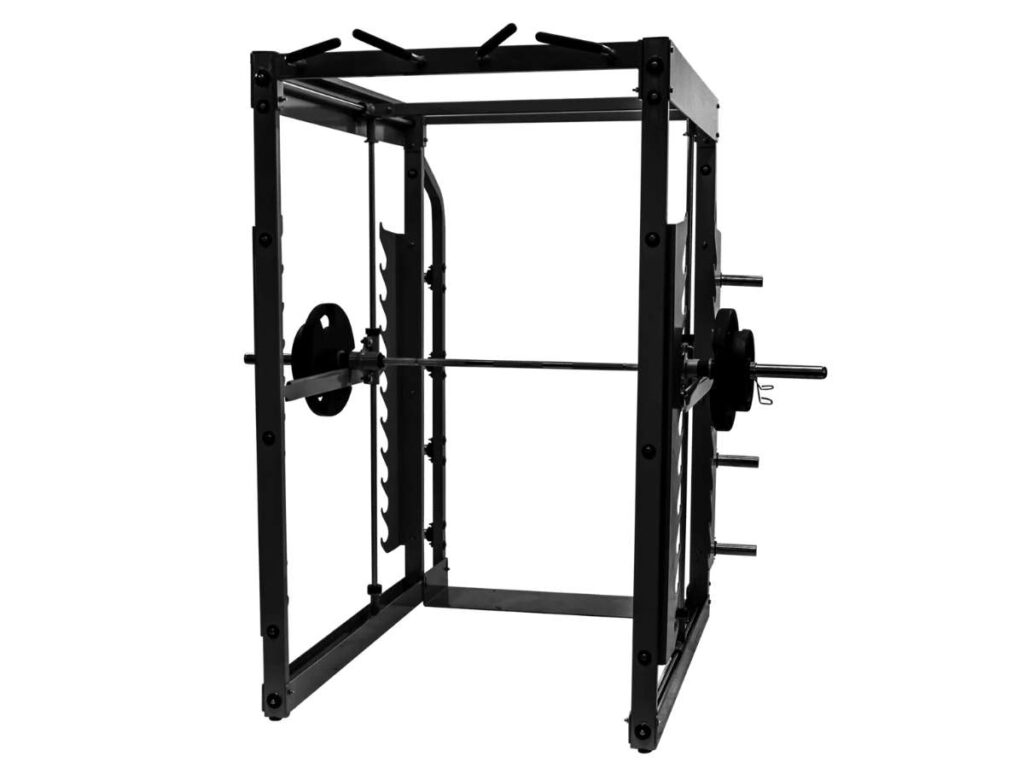
5. All-In-One Smith Machine
If you’re tight on space but want to offer a full range of training options, this machine might be your answer. The all-in-one Smith machine is exactly what it sounds like a multi-function station built around a Smith frame.
It combines multiple machines into one footprint. You’ll often get a Smith system, cable pulleys, pull-up bars, and even storage racks in a single unit.
I added one to a smaller location where space was limited and it quickly became the most used station in the room.
Average Cost: Usually priced between $2,500 to $5,000, depending on attachments.
Features
- Integrated Cable System: Dual adjustable pulleys for rows, flyes, and more.
- Pull-Up Bar Station: Built-in bar for bodyweight movements.
- Smith Rail with Add-Ons: Often includes leg press plate, dip handles, and band pegs.
- Plate & Barbell Storage: Helps keep the floor clear and organized.
- Compact Footprint: Combines 3–4 machines in the space of one.
- Multi-User Design: Lets two people train on different stations at the same time.
Advantages
- Maximizes Space: Great for smaller gyms or personal training studios.
- Increases Equipment Value: More functions for every dollar spent.
- Attracts Different Users: Appeals to both strength and functional training clients.
- Reduces Floor Clutter: Built-in storage keeps your gym cleaner.
- Efficient for Circuits: Users can transition from one move to the next fast.
- Boosts Member Perception: Feels like a premium offering without needing more room.
- Useful for Personal Trainers: Allows full-body sessions in one spot.
Disadvantages
- Steep Learning Curve: So many parts can confuse first-time users.
- Not Built for Heavy Loads: Some attachments aren’t made for serious max-out training.
- Takes Longer to Clean & Maintain: More parts means more upkeep and daily checks.
When the goal is to do more with less space—and offer variety without sacrificing safety—this machine delivers. It helped me get more out of every square foot, and for many gym owners, that’s a win worth the cost. How well are you using the space you already have?
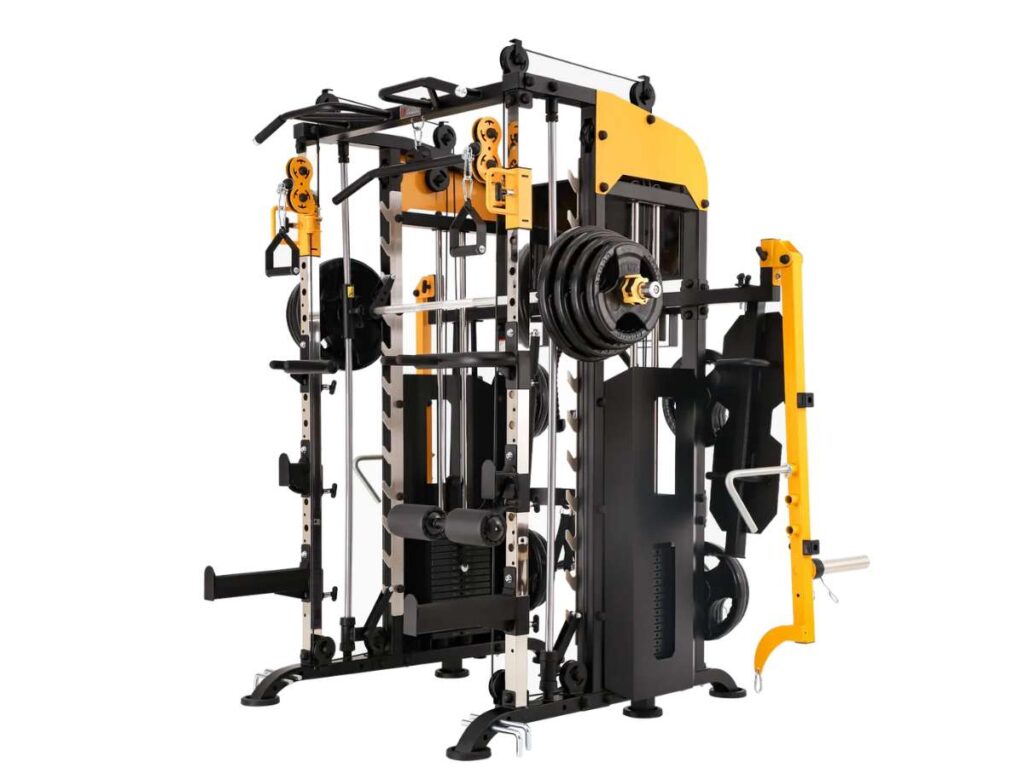
6. Commercial Smith Machines
If you’ve ever outfitted a high-traffic gym, you know some machines just aren’t built to last. That’s where commercial Smith machines come in. These are the heavy-duty models made for all-day use, by all types of lifters.
I bought one for my busiest location. And honestly, it’s one of the few machines that’s never given me a problem. No shaky frames. No worn-out parts. Just steady, day-in-day-out use.
They’re designed for durability first, and that makes them worth the higher price tag.
Average Cost: Ranges from $3,000 to $6,000, depending on materials and features.
Features
- Reinforced Steel Frame: Built to handle constant use and high weight loads.
- High-Grade Bearings: Keeps bar motion smooth, even after thousands of reps.
- Wider Footprint: Designed for better balance and user space.
- Heavier Starting Bar: Often starts at 35–45 lbs for stronger users.
- Rubber Foot Pads: Protects flooring in commercial spaces.
- Anti-Rust Coating: Helps extend machine life in humid or busy environments.
Advantages
- Built for Longevity: Withstands daily abuse without needing constant fixes.
- Attracts Serious Lifters: Heavy-duty feel adds trust and credibility.
- Reliable Performance: Fewer breakdowns = fewer service calls.
- Fits Busy Schedules: Ideal for gyms running group sessions or high-volume foot traffic.
- Brand Reputation: Often manufactured by leading fitness brands with strong support.
Disadvantages
- Higher Upfront Investment: Cost may not fit smaller gym budgets.
- Takes More Space: Not ideal for compact studio layouts.
- Less Beginner-Friendly: Heavier bar and larger design may intimidate new clients.
If you’re running a large facility or expanding into more serious training spaces, this machine pays for itself over time. It’s one of those purchases where you really feel the difference in quality—and so do your members. How long do you expect your equipment to last before replacing it? This one stretches that timeline.
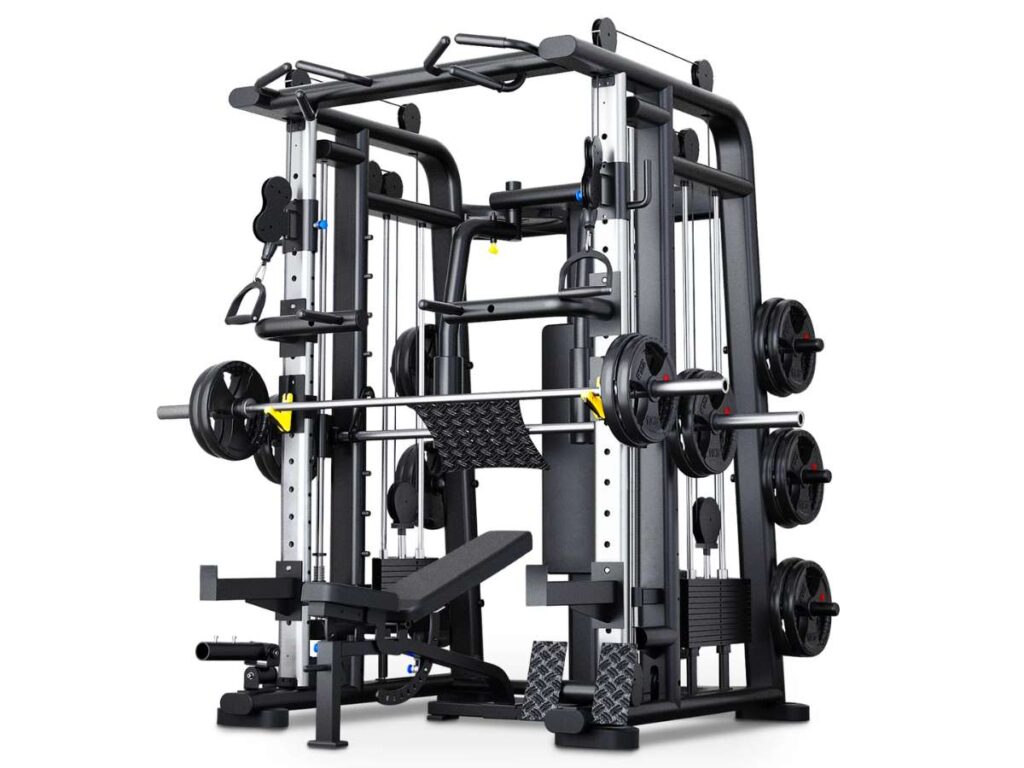
7. Home Smith Machines
A few years back, a client asked me to help set up a full gym in his garage. That’s when I started looking into home Smith machines. I was surprised how far they’ve come. Compact, quiet, and packed with just enough features to cover the basics.
These machines are built for personal use, not heavy foot traffic. But if you offer custom installs or work with home-based clients, they’re worth knowing about.
Average Cost: Typically ranges from $700 to $1,500.
Features
- Compact Frame Design: Fits in low-ceiling spaces like garages or basements.
- Lighter Bar Setup: Often starts at 15–25 lbs to suit casual lifters.
- Simple Cable Add-ons: May include basic pulleys for curls or lat pulldowns.
- Foldable Bench Options: Many models come with benches that fold for space saving.
- Quiet Operation: Designed with home noise levels in mind.
- Minimal Assembly Time: Easier to set up without a full crew.
Advantages
- Great for Home Installs: Perfect for private clients or small personal studios.
- Low Maintenance: Fewer parts mean less upkeep over time.
- Budget Friendly: Affordable entry point for solo lifters or boutique trainers.
- Custom Package Potential: Easy upsell if you’re offering full gym setup services.
- Quiet Training: No loud metal clanging—ideal for family spaces.
Disadvantages
- Limited Load Capacity: Not built for heavy lifting or high-intensity users.
- Shorter Lifespan: May wear faster under repeated commercial use.
- Basic Movement Options: Often lacks the range found in larger commercial units.
If you work with home gym clients or want to offer space-saving setups for small studios, this category opens doors. It’s not about max weight—it’s about making strength training accessible in more places. Have you considered offering these as part of your service package? It could be a simple way to expand your business.
8. Dual-Track Smith Machines
Some machines don’t look that different at first glance—but once your members use them, they’ll notice. That’s what I’ve found with dual-track Smith machines.
These models come with two separate guide rods, giving the bar a more stable and controlled path. The movement feels smoother than standard models, especially during slow, focused lifts. It’s a subtle upgrade, but one that makes a difference in day-to-day use.
If your clients care about control, safety, and consistency, this option stands out.
Average Cost: Generally between $2,500 and $4,500.
Features
- Dual Rail System: The bar glides along two tracks for better alignment.
- Controlled Range of Motion: Offers a balanced feel under load.
- Stability-Based Design: Reduces side sway during presses or squats.
- Linear Bearings: Keeps movement fluid with minimal resistance.
- Band Pegs Included: Easy to add variable resistance with bands.
- Compact but Solid Build: Designed for tight spaces without sacrificing stability.
Advantages
- Improves Balance: Helps members stay centered, especially under heavier weight.
- Supports Injury Rehab: Great tool for trainers working with recovering clients.
- Builds Confidence: Lifters feel secure with guided, stable movement.
- Works Across Skill Levels: Good for beginners and experienced members alike.
- Boosts Trainer Efficiency: Easier to spot and cue form corrections.
Disadvantages
- Limited Explosive Use: Not ideal for dynamic or speed-based workouts.
- Less Freedom: Advanced lifters may prefer more range than the dual-rail allows.
- Higher Upfront Cost: May not fit tight equipment budgets.
Dual-track smith machines is better if your gym serves people who need more support or form-focused training. I’ve seen it give lifters more control—and that leads to more consistent progress. Are your members looking for more stability in their lifts? This could be your answer.
9. Multi-Angle Smith Machines
Not every lifter moves the same way. That’s why I started paying attention to multi-angle Smith machines—they give your members options.
Instead of locking users into one bar path, this design lets them switch between multiple angles. Think of it like having several machines in one frame. Some models even allow slight adjustments mid-workout, giving a more natural training feel.
This type of machine isn’t common, but in the right gym, it stands out.
Average Cost: Falls between $3,000 and $5,500, depending on brand.
Features
- Adjustable Bar Path Angles: Users can switch from vertical to different tilt settings.
- Rotating Track System: Allows repositioning of bar movement direction.
- Built-In Position Locks: Secures each angle during training for safety.
- Neutral Grip Handles: Often includes grip variations to match lift styles.
- Compact-Medium Frame: Doesn’t demand too much floor space.
- Angle Labels & Guides: Helps users choose the right setting easily.
Advantages
- Customizable Experience: Members can choose the angle that suits their build and movement style.
- Joint-Friendly Options: Certain angles reduce pressure on wrists and shoulders.
- Increases Machine Use: Versatility means it gets used more often.
- Trainer Tool: Useful for programming lifts based on client needs or goals.
- Progressive Training: Adjusting angles can challenge different muscle groups.
Disadvantages
- More Complex to Teach: First-time users may need more guidance.
- Longer Setup Time: Adjustments can slow down sessions.
- Higher Price Tag: Versatility costs more than single-path machines.
If you’re offering personalized training or small group coaching, this machine brings flexibility and value. It helped my staff tailor workouts better—and members noticed. Do your lifters need more than just “up and down”? This might be your upgrade.
Conclusion
Every gym is different. So is every Smith machine.
Some are built for beginners. Others for pros. Some do it all.
You’ve just explored all 9 types clearly, quickly, and with real talk.
Choose the one that speaks to your members’ needs. Don’t wait for breakdowns or complaints to force the upgrade.
YR Fitness has quality, durability, and support to help you get it right the first time.
Contact us today and let’s talk through what fits your floor plan and goals!
Related articles:
